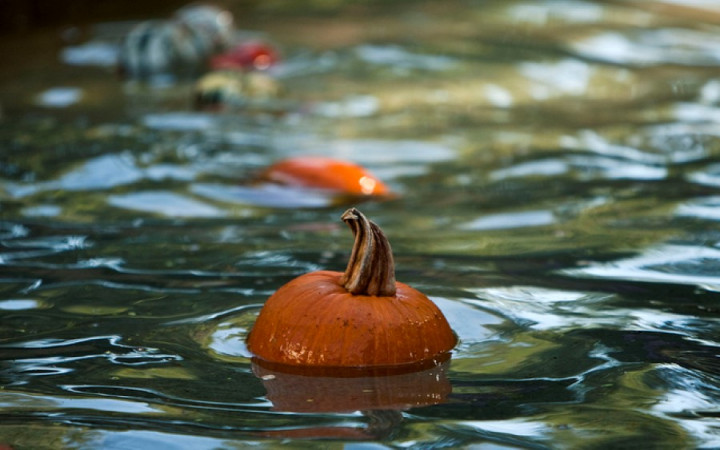Do Pumpkins Float In Water
Have you ever wondered if pumpkins float in water? It's a curious question that has piqued the interest of many. In this blog post, we will dive deeper into the topic of do pumpkins float in water and explore the science behind it.
Pain Points
When planning a pumpkin carving or decorating activity, there's always the fear of the pumpkin sinking once it's placed in water. It can be frustrating to see all the hard work go to waste, and it becomes a hassle to find a container that can fit the pumpkin and keep it afloat. This is especially true when dealing with bigger pumpkins. Additionally, some may wonder if the size or weight of the pumpkin plays a role in whether it floats or sinks.
The Answer
Yes, pumpkins float in water! The reason why pumpkins float is because they are less dense than water. When an object is placed in water, it displaces the water equal to its weight. If the object weighs less than the water it displaced, it will float. Since pumpkins are mostly hollow and filled with air, they have a lower density than water and thus, float. The size and weight do affect how easily the pumpkin can float, but as long as it has enough air inside, it should float.
Main Points
In summary, pumpkins float in water because they are less dense than water. The size and weight can affect how easily they float, but as long as there is enough air inside, they should float. When planning a pumpkin decorating activity, it's important to take into consideration the size of the container and the size and weight of the pumpkin.
Personal Experience
When I was younger, my family used to hold a pumpkin decorating contest every Halloween. We would all gather around the table, armed with our carving tools and a variety of decorating items, including paint, glitter, and markers. After we finished decorating our pumpkins, we would then place them in a big container filled with water to test if they would float. I remember being ecstatic when my pumpkin would float because it meant that my design was worthy of a prize. Knowing that the air inside the pumpkin was the reason why it floated, made me appreciate the science behind it.
Density of Pumpkins
The density of a pumpkin is affected by its size and the amount of air inside. The bigger the pumpkin, the more air it can potentially hold, which makes it less dense than water. However, if the pumpkin is not hollow inside and has a lot of flesh and seeds, it may not float since it is denser than water. Similarly, if the pumpkin is too small and doesn't have enough air inside, it may also sink in water.
Shape of Pumpkins
The shape of the pumpkin can also play a role in whether it floats or sinks. Pumpkins that are round and symmetrical tend to float more easily than those that have irregular shapes. This is because round pumpkins have a uniform distribution of air inside, while irregularly shaped pumpkins may have areas that are denser than other parts, causing it to sink.
Effect of Temperature
The temperature of the water can also affect whether pumpkins float or sink. Since air expands when heated and contracts when cooled, warm water would cause the air inside the pumpkin to expand, making it more buoyant and float more easily. On the other hand, cold water would cause the air inside to contract, making it denser and harder to float.
Question and Answer
Q: Can all pumpkins float in water?
A: Not all pumpkins can float in water. Pumpkins that are too small or too dense may not have enough air inside to make them less dense than water, causing them to sink.
Q: Does the weight of the pumpkin affect whether it will float?
A: Yes, the weight of the pumpkin can affect whether it will float. Heavier pumpkins require more air inside to make them less dense than water, making it harder to keep them afloat.
Q: Why do pumpkins have air inside?
A: Pumpkins have air inside because it helps them to grow and maintain their shape. The air pockets also provide insulation to the inside of the pumpkin, protecting the seeds and flesh from extreme temperatures.
Q: What is the best container to use when testing if a pumpkin can float?
A: The best container to use is a deep container that can hold enough water to fully submerge the pumpkin. The container should also be wide enough to accommodate the size of the pumpkin without touching the sides.
Conclusion
In conclusion, pumpkins do float in water, and it's all because of their density. The size and weight of the pumpkin can affect how easily it floats, but as long as there is enough air inside, it should float. So the next time you plan a pumpkin decorating contest or activity, don't hesitate to test if your pumpkin will float!
Gallery
Pumpkin Experiment: Do Pumpkins Sink Or Float? - Miss Ashlee's Class

Photo Credit by: bing.com /
Exploring Our World: Do Pumpkins Float? - 4-H Science, Technology

Photo Credit by: bing.com / pumpkins aboboreira float abobora discovering
Celebrate Halloween At The Floating Pumpkin Patch | City Of Corpus Christi

Photo Credit by: bing.com / floating pumpkin patch
Do Pumpkins Float? - Baby Shower Easy

Photo Credit by: bing.com / pumpkins
Do Pumpkins Float Or Sink? | Wonderopolis

Photo Credit by: bing.com / float pumpkins sink wonderopolis science physical